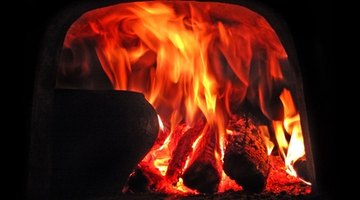How to Hook Up and Run a Franklin Stove
The Franklin stove was invented by Benjamin Franklin as an attempt to create a more efficient heating source than the drafty fireplaces of his day. Versions of this cast iron stove, which is a box shape with doors on the front and baffles in the back to direct the smoke, are still being manufactured. With some attention to safety and local building codes, installing a Franklin stove can be a straightforward process for a skilled homeowner. Well-seasoned firewood is the fuel most often used in a Franklin stove.
Installation of a Franklin stove

-
Check with local building codes for help in placing the stove the correct and safe distance from combustible walls. The stove needs to be set on a fireproof pad as well, such as a metal sheet or a brick or rock platform. Check the distances from the walls, ceiling and furniture.
-
Unpack the stove, if you purchased a new one, and tip it back to attach the three legs on the bottom, using the included bolts and washers.
-
Set the stove upright and locate the flue adapter and gasket, also included with a new stove. The rectangular flue piece goes over the hole, either in the top or rear of the stove box, to allow the smoke to escape up the chimney. Position the fireproof gasket at the base of the flue adapter and tighten it onto the stove with the screws included in the kit.
-
Set the grate and ashpan inside the the stove. The ashpan goes beneath the grate, which has slits in it for the ash to fall through. The ashpan often has a handle to help in removing the ashes.
-
Set the stove in place on the fireproof platform or metal plate, and attach the chimney pipe to the flue, and then to the house chimney. The house chimney should not be shared with any other stove.
Use of the Franklin stove
-
Become familiar with the two air flow controls or dampers. The control to the main one is in the lower part of the door. A secondary control is located in the upper left corner of the stove door. These regulate the air flow to the fire and the intensity of the flames. The upper one should always be left open.
-
Open the lower air vent and lay crumpled newspaper or fire starter on the grate. Add kindling and a couple of small logs. Light the paper and close the door.
-
Light a small fire in the center of the stove the first time you use it, or after a long inactive period. Keep the fire going about three hours, gradually increasing the intensity. Ventilate the room if an odor occurs the first time you use the stove. It is harmless, but allow the fire to burn until all the smell is gone.
-
Add logs to the stove by opening the door slowly and placing the logs on the burning fire. Open the lower damper for a few minutes until the logs begin burning, then close it again.
References
Warnings
- Warn small children about the dangers of a hot stove.
- Beware of curtains or furnishings getting too close to the stove.
- Do not burn wet or unseasoned wood in the stove, as it increases creosote buildup in your stove.
Writer Bio
Margaret Mills has been writing for more than 30 years, focusing on articles about religion, forestry, gardening and crafts. Her work has appeared in religious periodicals including "Focus on the Family" and similar publications. Mills has a Bachelor of Arts in English from Northwest Nazarene University.
Photo Credits
- Traditional russian stove. Process of cooking. image by diter from Fotolia.com
More Articles



